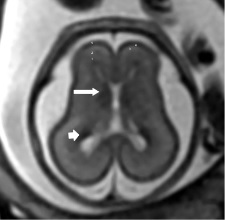Ganglionic Eminence: Anatomy and Pathology in Fetal MRI
DOI:
https://doi.org/10.53903/01212095.7Keywords:
Cavitation, Magnetic resonance imaging, Embryonic developmentAbstract
We present two cases of fetal MRI where anomalies of the ganglionic eminences (GE) are detected, one case in a single pregnancy and another in a twin gestation with only one of the affected fetuses. Alterations in the ganglionic eminences are rare entities, with very few published cases, both by MRI and fetal ultrasound, which are usually associated with severe neurological alterations. The MR findings of the pathology of the GE in these two cases are described. These findings were not visible on the previous ultrasound.
Downloads
References
Prefumo F, Petrilli G, Palumbo G, Sartori E, Izzi C, Pinelli L. Prenatal ultrasound diagnosis of cavitation of ganglionic eminence. Ultrasound Obstetr Gynecol. 2019;54:558-60. https://doi.org/10.1002/uog.20236
Wonders C, Anderson SA. Cortical interneurons and their origins. The Neuroscientist. 2005;11:199-205. https://doi.org/10.1177/1073858404270968
Marín O. Origen de las interneuronas de la corteza cerebral: conceptos básicos e implicaciones clínicas. Rev Neurol. 2002;35:743-51. https://doi.org/10.33588/rn.3508.2002460
Kolasinski J, Takahashi E, Stevens A, Benner T, Fischl B, Zöllei L, et al. Radial and tangential neuronal migration pathways in the human fetal brain: Anatomically distinct patterns of diffusion MRI coherence. NeuroImage. 2013;79:412-22. https://doi.org/10.1016/j.neuroimage.2013.04.125
Zecevic N, Hu F, Jakovcevski I. Interneurons in the developing human neocortex. Develop Neurobiol. 2010;71:18-33. https://doi.org/10.1002/dneu.20812
Abdel Razek AA, Kandell AY, Elsorogy LG, Elmongy A, Basett AA. Disorders of cortical formation: MR imaging features. AJNR Am J Neuroradiol. 2009;30:4-11. https://doi.org/10.3174/ajnr.A1223
Arshad A, Vose L R, Vinukonda G, Hu F, Yoshikawa K, Csiszar A, et al. Extended production of cortical interneurons into the third trimester of human gestation. Cerebral Cortex. 2015;26:2242-56. https://doi.org/10.1093/cercor/bhv074
Yozu M, Tabata H, Nakajima K. The caudal migratory stream: A novel migratory stream of interneurons derived from the caudal ganglionic eminence in the developing mouse forebrain. J Neuroscience. 2005;25:7268-77. https://doi.org/10.1523/JNEUROSCI.2072-05.2005
Wei S, Du H, Li Z, Tao G, Xu Z, Song X, et al. Transcription factors Sp8 and Sp9 regulate the development of caudal ganglionic eminence-derived cortical interneurons. J Comparative Neurol. 2019;527:2860-74. https://doi.org/10.1002/cne.24712
Righini A, Cesaretti C, Conte G, Parazzini C, Frassoni C, Bulfamante G, et al. Expan- ding the spectrum of human ganglionic eminence region anomalies on fetal magnetic resonance imaging. Neuroradiology. 2015;58:293-300. https://doi.org/10.1007/s00234-015-1622-5
Righini A, Frassoni C, Inverardi F, Parazzini C, Mei D, Doneda C, et al. Bilateral cavitations of ganglionic eminence: A fetal MR imaging sign of halted brain development. AJNR Am J Neuroradiol. 2013;34:1841-5. https://doi.org/10.3174/ajnr.A3508

Downloads
Published
How to Cite
Issue
Section
License
Copyright (c) 2020 Revista Colombiana de Radiología

This work is licensed under a Creative Commons Attribution-NonCommercial-ShareAlike 4.0 International License.
La Revista Colombiana de Radiología es de acceso abierto y todos sus artículos se encuentran libre y completamente disponibles en línea para todo público sin costo alguno.
Los derechos patrimoniales de autor de los textos y de las imágenes del artículo como han sido transferidos pertenecen a la Asociación Colombiana de Radiología (ACR). Por tanto para su reproducción es necesario solicitar permisos y se debe hacer referencia al artículo de la Revista Colombiana de Radiología en las presentaciones o artículos nuevos donde se incluyan.







